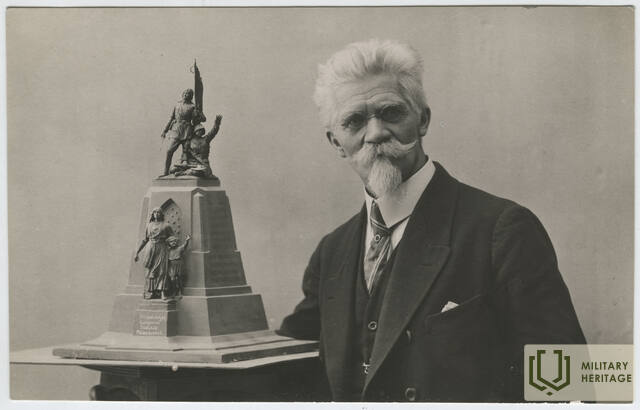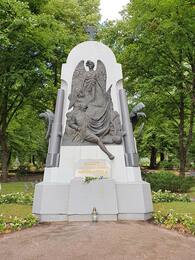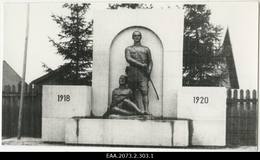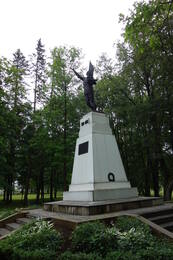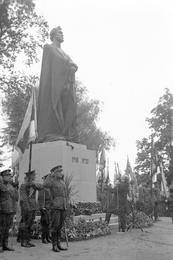Amanduss Ādamsons (1855-1929) I Neatkarības kari
Igauņu tēlnieks, akadēmiķis un viens no Igaunijas nacionālās mākslas pamatlicējiem.
Amandus Heinrihs Ādamsons dzimis 1835. gada 12. novembrī Pakri pussalā. Viņa mākslinieciskā dāvana tika atklāta agri, viņš it kā izgrebja savu pirmo koka figūru savam brālim, pirms iemācījās lasīt.
Neskatoties uz savu pazemīgo izcelsmi un vairākiem neveiksmīgiem mēģinājumiem iestāties, Ādamsons 1876. gadā paspēja iestāties Sanktpēterburgas Mākslas akadēmijā kā viesstudents, kuru absolvēja 1879. gadā ar sudraba medaļu. Viņš kļuva par ārštata mākslinieku Sanktpēterburgā un drīz sāka saņemt pasūtījumus no aristokrātijas un pat suverēna ģimenes. 1887. gada 8. aprīlī viņš atklāja savu pirmo personālizstādi Sanktpēterburgā. Ādamsons Parīzē dzīvoja no 1887. līdz 1891. gadam, kas bija mākslinieciski produktīvs periods, kurā viņš attīstīja savu stilu. 1889. gadā viņš divus savus darbus pieteica Parīzes ekspozīcijā Universelle un ieguva balvu.
1901. gadā Ādamsons pievērsās monumentālu skulptūru projektēšanai. Viņa pirmais pasūtījums bija Krievijas karakuģa Russalka nogrimšanas piemineklis Tallinā (1902) – pirmais igauņu tēlnieka piemineklis Igaunijā.
1907. gadā Ādamsons kļuva par Sanktpēterburgas Mākslas akadēmijas akadēmiķi un pasniedza daudzus, tostarp slavenus igauņu māksliniekus Nikolaju Trīku un Konrādu Mēgi.
Sākoties Krievijas revolūcijai, Ādamsons atgriezās Igaunijā un apmetās uz dzīvi Paldiski pilsētā, vēlāk ik pa laikam dzīvoja un strādāja Itālijā.
Viņa darbi ir neobaroka stilā ar reālistiskām ietekmēm un bieži vien ir alegoriski. Viņš ir veidojis daudzus Neatkarības kara pieminekļus (Pērnavā, Valgā, Rakverē, Narva-Jēsū, Vīlandē, Sūre-Jāni, Kuresāre, Kalevipoega statuja Tartu pie Emajegi upes).
Ādamsons nomira 1929. gada 26. jūnijā savās mājās Paldiskos. Viņš ir apbedīts pie viņa projektētā Brīvības cīņu pieminekļa Pērnavā. Ādamsonu ģimene mākslinieka vasaras darbnīcas māju Paldiskos nodeva Igaunijas valdībai 2005. gadā. Amandus Adamson studijas muzejs tika atvērts kā Harjumaa muzeja filiāle 2010. gadā.
Saistītie objekti
Brīvības cīņu piemineklis Pērnavā
Pērnavā esošā pieminekļa meta (rasējuma) autors ir Amandus Ādamsons. Pieminekli Alevi kapsētā atklāja 1922. gada 16. jūlijā. Tēlnieku apglabāja blakus piemineklim 1929. gadā.
1945. gada 15. aprīlī pieminekli saspridzināja gabalos, kurus pēc tam apraka. Skulptūru, kas ataino zēnu ar ziedu vītni, vietējās vidusskolas audzēknes apraka 175 metrus no pieminekļa. Par laimi, kareivju kapi palika neskarti.
Garnizona kapsētu atjaunoja 1987. gadā, un 1988. gadā izraka pieminekļa daļas (arī zēna un ziedu vītnes skulptūru). 1989. gada 24. februārī pieminekļa augšējā daļa, ko atrada apraktu pieminekļa sākotnējā atrašanās vietā, tika svinīgi jaunatklāta ar granīta plāksni, kurā iegravēts teksts: “1918.–1920. / Šeit 1922. gada 16. jūlijā tika atklāts piemineklis Brīvības cīņās kritušo piemiņai / Tēlnieks Amandus Ādamsons / Iznīcināts 1945. gadā / 24.02.1989. P.M.S.”
Visi pieminekļa un kapsētas atjaunošanas darbi norisinājās pa posmiem. Pieminekli atkal atklāja 1993. gada 17. jūlijā.
Piemineklis Brīvības cīņām Sv. Pāvila kapos
Šis piemineklis atrodas Tartu Sv. Pāvila kapsētas ziemeļu stūrī.
To veidojuši tēlnieks Aleksandrs Ellers un pilsētas arhitekts Arnolds Matejs, tajā attēloti divi Amanda Ādamsona veidoti karavīri, un tas tika atklāts 1934. gada 11. novembrī. Padomju okupācijas laikā skulptūras un datumi no pieminekļa tika noņemti. 2015. gada 10. oktobrī tajā pašā vietā tika atklāts Neatkarības kara memoriāls, kurā ietilpst Mati Karmina skulptūra "Kaļevs un Linda", kā arī Mati Karmina un Tīta Trummala projektētais svinīgais laukums ar celiņiem, parka soliņiem un virziena gaismām. Piemineklis iezīmē 254 Brīvības cīņās kritušo karavīru masu kapu.
Brīvības cīņu piemineklis Valgā
Brīvības cīņās kritušo Dienvidigaunijas kareivju piemiņai veidotajā piemineklī attēlota nezināma kareivja statuja uz augstas pamatnes. Viņam pie sāniem karājas zobens, vienā rokā viņš tur karogu, bet otra roka ir izstiepta gaisā. Sākotnējo pieminekli atklāja leitnanta Jūlija Kuperjanova 31. dzimšanas dienā 1925. gada 11. oktobrī, bet padomju režīms to iznīcināja 1940. gada 21. septembra naktī. Pieminekli tā kādreizējā atrašanās vietā Kuperjanova ielā Valgā atklāja 2013. gada 16. augustā. Oriģinālo pieminekli 1925. gadā veidoja tēlnieks Amandus Ādamsons, kurš arī uzraudzīja bronzas skulptūras liešanas procesu Itālijā. Skulptūru pilnā izmērā atjaunoja tēlnieks Jāks Soanss. Restaurācijas darbus organizēja bezpeļņas organizācija “VIKP” (Pastāvīgā patriotiskās izglītības ekspozīcija Valgā), Valgas pilsētas un apriņķa pašpārvalde un Igaunijas Kara muzejs.
Piemineklis Brīvības cīņām Tartu
Šis piemineklis atrodas Emajegi upes labajā krastā pie Vabaduse avēnijas (starp Vabaduse un Kaarsilla tiltiem) Tartu.
To projektējis Amanduss Ādamsons, tas tika atklāts 1933. gada 17. septembrī, un tajā bija bronzas skulptūra, kurā attēlots igauņu episkā varoņa Kalevipoegs, kurš noliecies uz zobena. Piemineklis tika noņemts 1950. gadā, bet, cilvēkiem turpinot nest uz vietu ziedus un sveces, 1952. gadā tajā tika atklāta rakstnieka Frīdriha Reinholda Kreicvalda biste. Atjaunotais piemineklis, ko pēc senām fotogrāfijām veidojis tēlnieks Ekke Väli 2003. gada 22. jūnijs.




